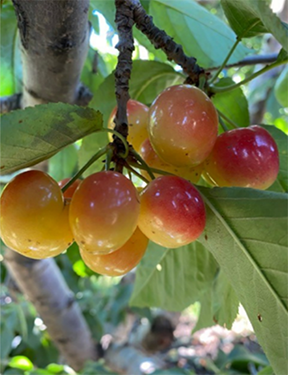The California Department of Food and Agriculture (CDFA) Fertilizer Research and Education Program (FREP) annually funds and coordinates research to advance the environmentally safe and agronomically sound use and handling of fertilizer materials. Since 1990, FREP has funded such research on many of California’s important and environmentally sensitive cropping systems. The FREP Research and Project Database aims to make the wealth of information contained in FREP research projects readily available, easily understandable and convenient for growers to implement.
The following two research projects were recently completed, added to the FREP Database and blogged about in FREP’s Research Update series:
Development of Nutrient Budget and Nutrient Demand Model for Nitrogen Management in Cherry

Overview: Often the last trees to bloom and the first to harvest each season, California sweet cherry growers have a short window to make nitrogen (N) management decisions and in-season adjustments. Historically, cherry growers have utilized leaf sampling and critical values to manage N. While these tools can be useful for diagnosing a deficiency, alternate approaches may offer a better means for managing fertilization in this high value crop. In this project, the team collected measurements from three highly productive cherry groves to improve N fertilizer management tools available to California growers.
Key Takeaways: This project demonstrated that fertilizer use in mature California cherry groves can be optimized if N applications are adjusted based on tree demand and seasonal uptake patterns.
- Tree Demand: N demand was determined to be an average of 2.59 lbs. per 1000 lbs. of harvested fruit plus an average of 28.3 lbs. per acre for perennial tissue growth and maintenance.
- Seasonal Uptake Patterns: Starting approx. 30 days after bloom, N uptake from the soil occurs rapidly through the fruit development and vegetative growth stages with up to 90% of uptake occurring by September.
Click here for more information in this project’s Research Update blog.
Achieving Efficient Nitrogen Fertilizer Management in California Wheat

Overview: Wheat and other small grains are grown in diverse agricultural environments throughout California. Approximately 90% of the wheat, triticale, and barley in California is fall-sown and relies to some degree on precipitation that varies dramatically across the state. These conditions make efficient nitrogen (N) fertilizer management difficult because the right rate varies from field-to-field and year-to-year. Therefore, the goal of this project was to demonstrate and enable new ways of achieving best N management practices in California wheat and related winter cereals.
Key Takeaways: This project demonstrated that California wheat growers can effectively increase crop productivity and save N fertilizer by using:
- N-Rich Reference Zones
- Plant and Soil Measurements
- UC Nitrogen Fertilizer Management Tool for California Wheat
Click here for more information in this project’s Research Update blog.


